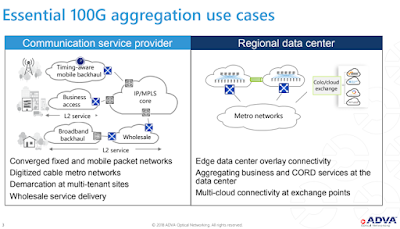 Global IP traffic across public and private networks is expected to reach 396 exabytes per month by 2022, up from 122 exabytes per month in 2017, according to Cisco's newly updated Visual Networking Index (VNI). Essentially, global IP traffic will triple in the 5 year period driven by more users, devices, higher resolution video and other trends.
Global IP traffic across public and private networks is expected to reach 396 exabytes per month by 2022, up from 122 exabytes per month in 2017, according to Cisco's newly updated Visual Networking Index (VNI). Essentially, global IP traffic will triple in the 5 year period driven by more users, devices, higher resolution video and other trends."Since we first started the VNI Forecast in 2005, traffic has increased 56-fold, amassing a 36 percent CAGR with more people, devices and applications accessing IP networks,” said Jonathan Davidson, senior vice president and general manager, Service Provider Business, Cisco. “Global service providers are focused on transforming their networks to better manage and route traffic, while delivering premium experiences. Our ongoing research helps us gain and share valuable insights into technology and architectural transitions our customers must make to succeed.”
Cisco's forecasting relies upon independent analyst forecasts and real-world network usage data.
Some highlights of the latest Cisco VNI:
- By 2022, there will be 28.5 billion fixed and mobile personal devices and connections, up from 18 billion in 2017—or 3.6 networked devices/connections per person, from 2.4 per person.
- More than half of all devices and connections will be machine-to-machine by 2022, up from 34 percent in 2017.
- By 2022, Average global fixed broadband speeds will nearly double from 39.0 Mbps to 75.4 Mbps.
- Average global Wi-Fi connection speeds will more than double from 24.4 Mbps to 54.0 Mbps.
- Average global mobile connection speeds will more than triple from 8.7 Mbps to 28.5 Mbps.
- IP video traffic will quadruple by 2022. As a result, it will make up an even larger percentage of total IP traffic than before—up to 82 percent from 75 percent.
- Gaming traffic is expected to grow nine-fold from 2017 to 2022. It will represent four percent of overall IP traffic in 2022.
- Virtual and augmented reality traffic will skyrocket as more consumers and businesses use the technologies. By 2022, virtual and augmented reality traffic will reach 4.02 exabytes/month, up from 0.33 exabytes/month in 2017.
Regional IP traffic growth details (2017 – 2022)
APAC: 173 exabytes/month by 2022, 32 percent CAGR, four-times growth
North America: 108 exabytes/month by 2022, 21 percent CAGR, three-times growth
Western Europe: 50 exabytes/month 2022, 22 percent CAGR, three-times growth
Central & Eastern Europe: 25 exabytes/month by 2022, 26 percent CAGR, three-times growth
Middle East and Africa: 21 exabytes/month by 2022, 41 percent CAGR, six-times growth
Latin America: 19 exabytes/month by 2022, 21 percent CAGR, three-times growth
https://www.cisco.com/c/en/us/solutions/collateral/service-provider/visual-networking-index-vni/white-paper-c11-741490.html























